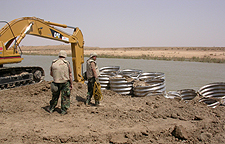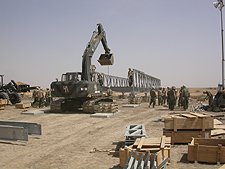MESOPOTAMIA VALLEY, IRAQAs coalition forces pushed forward, military engineers servicing the 250-mile-long supply line must use speed and ingenuity. To devise a crossing of the swiftly flowing Saddam irrigation canal in southern Iraq's Tigris-Euphrates Valley, Rear Admiral Chuck Kubic turned to a coterie of engineers he fondly calls his "Seabee jedi." On April 1, one day before elements of the 1st Marine Division crossed the Tigris to close within 18 miles of Baghdad, the admiral included the bridge site on a daylong whirlwind inspection of Marine Engineer Group projects and staging areas along the main supply route.
The mission had many purposes: mail and personnel drops and briefings with field commanders about supplies, logistics and progress. A quick check on a never-before-attempted bridging technique ranked high on Kubic's checklist. He is a registered engineer licensed to practice in Pennsylvania and Virginia and a qualified Seabee combat warfare specialist. The MEG boss believed the strategically important bridge was worth a firsthand look. "What we're going to see today represents a year of planning," he said. "Only the Seabees could do this."
On his rapid inspection, Kubic, in charge of engineering support for the First Marine Expeditionary Force (I MEF) took support staff and a reporter into southern Iraq about 100 miles north of the demilitarized zone with Kuwait. The group left MEG's Camp Commando field headquarters in central Kuwait shortly before 9 a.m. local time in a pair of twin-rotor CH-46 "Frog" helicopters. On each chopper, gunners manned twin .50-caliber machine guns, a standard security measure that was not put into use on this day.
The area is by no means 100% secure, however. The allied advance toward Baghdad has moved so quickly that civilian-clothed Iraqi irregular "left-behinds" and the Saddam fedayeen death squads have harassed supply convoys in the Tigris-Euphrates Valley region in recent days. We learn in the field that a tanker truck went missing one night last week. A search team found the truck in a river and assumed the driver had fallen asleep or lost his way in a sandstorm. But when divers secured the vehicle to pull it from the river, they discovered that the driver died from a gunshot wound to his forehead.
Further south, two Scud alarms roused Camp Commando in the early morning hours before the admiral's tour; another sounded in the morning, shortly after his flight departed. There have been 38 alarms to date in the camp, said one Seabee at headquarters. Several were apparently drills or false alarms. Only two missiles are known to have penetrated Patriot anti-missile defenses. One fell harmlessly outside the camp perimeter; the other landed close to a Kuwait City shopping center. The concussion injured four people slightly.
At the chopper's first stop, a Seabee contingent out of Port Hueneme, Calif., is bridging an irrigation canal at a breakneck pace. The crossing will enable the supply line to bypass several cities between Basra and Baghdad, removing an opportunity for the Iraqis to bring the battle to an urban setting. Naval Marine Construction Battalion Four, supported by a small team of divers from Underwater Construction Team 2 out of Port Hueneme, is constructing a 61-m-long, 16-m-wide bridge. The Mabey-Johnson temporary span is "really one of many offshoots of the Bailey bridge," says Kubic.
 |
| Sheet pile culvert modules proved a quick and efficient solution to underpinning bridge. |
While NMCB-4's commanding officer, Col. Jim Worcester, briefs the admiral, officer in charge Lt. Marc Rouleau oversees a Seabee hive of activity. Assisted by a 4-ton forklift with a hook attachment, one crew is busy sledge hammering pins into place on the bridge "nose." Each bay is 10 ft long and the assemblage is placed on 4 x 4-in. cribbing. As the span takes shape, grillages and distribution beams spread the load. The nose is angled upward by about 10°, to keep the center of gravity over the landward side during launching. The fully assembled structure will weigh 135 tons with the nose and 105 tons once the steel proboscis is disassembled and removed, says Chief Petty Officer George Freese.
The crew planned to ferry a four-ton forklift across the river a few hundred yards downstream to help disassemble the nose once the canal was spanned. "We'll jack it down onto cribs, place a spreader beam and disassemble it," says Rouleau. "It should take about 14 hours." As it turned out, the Seabees could not transport the forklift across the canal, so they took it apart maually.
 |
| Temporary bridge takes shape. |
Kubic would have preferred to buy a portable bridge from a U.S. manufacturer, but "no one could really match the flexibility and combination of configurations they offered us." A mid- January site visit to their ISO 9001-rated, Gloucester, U.K., factory reconfirmed the decision. "Their quality control is excellent and their plant is state-of-the-art, with robotics," he says. A pair of Mabey-Johnson technical advisors, a retired British commando and a former U.S. Army combat engineer, came to Kuwait before the war started, but the firm's legal department ordered them to return home. The assembled bridge will be able to support between 70 and 80 tons, says Rouleau. "It will handle an M-1 Abrams tank," he says.
 |
| Canal crossing allowed troops to avoid cities. |
A pair of Caterpillar D-7 bulldozers moved rubble from a borrow pile about 30 yards downstream, placing it on the in earthen foundation abutment. "We've been sheep-footing the ground on the approach path," Rouleau adds. "It's important to have this bridge good to go ASAP."
But what sets the project in a unique category is the substructure's underpinning: sheet pile culvert modules (SPCM, pronounced "spickum") that armor the earthen launching abutment upstream face and toe. The canal, which is 73 m wide and 3 m deep in places, flows at a rate of 3 m per second. The design team, headed by Lt. Dave McAlister, wanted to extend an earthen mole pier far enough to narrow the canal's width sufficiently to create an abutment. This enables the bridge to span the channel. At the same time they knew that they must contend with the scouring that would be induced by the increased flow velocity.
 |
| Troops place "Mac Moles" to cross irrigation canal. |
The standard solution would be sheet piles, but they are cumbersome and difficult to transport in a war zone, where every square foot of space on a convoy is precious. In addition, the team looked for materials that would be in abundant supply for this and other Seabee missions. Seabee jedi team members McAlister, Lt. (jg) Eric Ulmen and LCDR. Russ Seignious conceived the SPCM late one night last December in a tent in Kuwait.
In February MEG tapped available Seabees to field test the earthen pier-SPCM concept, also dubbed a Mac mole in McAlister's honor. They trucked in stacked sections of corrugated culvert 72 in. in diameter and 12 ft long on a flatbed truck. The team first bolts together sections, then lashes them together with wire rope in groups of three. A backhoe operator, using a wire rope hung from the bucket, picks each triangular assemblage, tilts it vertically and deftly wiggles it into place in the canal sediment. A backhoe fills each SPCM with dirt, providing mass and structural integrity. Interlocking overlapping placement provides additional strength to the toe and armors the earthern pier. Earth overtopping completes the substructure's armor. "If we want to make this permanent when the war is over, we'll place sheetpiling as required," says McAlister.
The Seabees practiced assembly in the desert in February. "Out here, I've got my A-team, my instructors on the job," says Rouleau. "And the dirt is working better than the sand." Pointing to the crimped tops of the first few Mac molds, he says, "Doesn't look very pretty, but we're getting it done." The goal: to have the crossing spanned and several kilometers of approach road ready to roll by the end of the following day.
Assured that all is in order on the jobsite, Kubic discusses security arrangements with his cadre before boarding the Frog and heading for the next stop. "I don't think the Iraqi command knows we're here yet, since these guys started this morning. But they'll know, probably by tomorrow night. So these folks will have to defend the bridge after they construct it." He seemed confident that the Seabees' bridge defense would be as efficient as their construction. (NMCB-4 reported on April 2 that the canal had been crossed successfully and after minimal work to the approaches, a convoy could roll by midnight. It was a year in the planning, but executing the job took well under 75 hours, from start to finish.)
(Photos by Andrew G. Wright for ENR)
![]()
 |
ENR Managing Senior Editor Andrew G. Wright is in Baghdad
with the Engineer Brigade of U.S. Army's Third Infantry
Division.
